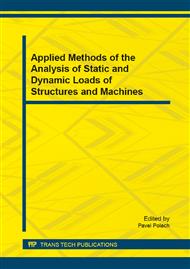p.227
p.231
p.235
p.239
p.247
p.253
p.257
p.261
p.267
Modal Parameter Analysis for Underdamped Mechanical Systems
Abstract:
There are many ways to model and to analyze discrete event systems. In general these systems lead to a non-linear characteristic equation description in linear algebra. This paper presents an analytical method for solving the characteristic equation of higher order, which arise when solving ordinary differential equations of motion of rigid body systems with 2 ≤ p° ≤ 10 degrees of freedom. The objective of this work was to express the characteristic equation in the form of product quadratic polynomial, from which the modal components could be found. To validate the model, the modal parameters extraction technique – Ibrahim Time Domain (ITD) – was used to extract modal parameters from artificial data developed in MATLAB environment. The extracted modal components were compared to those obtained from the analytical model.
Info:
Periodical:
Pages:
247-252
Citation:
Online since:
February 2015
Authors:
Price:
Сopyright:
© 2015 Trans Tech Publications Ltd. All Rights Reserved
Share:
Citation:


